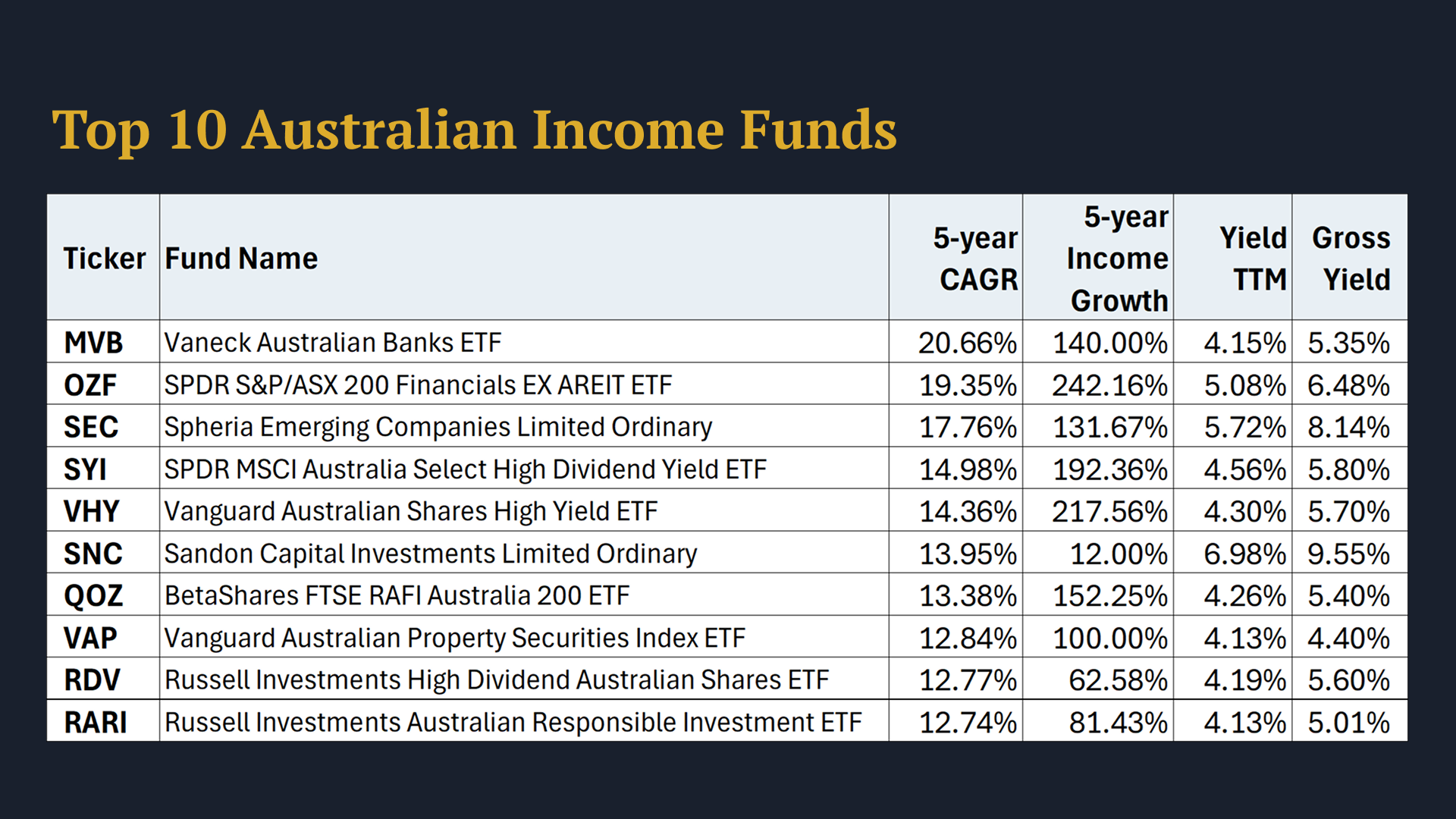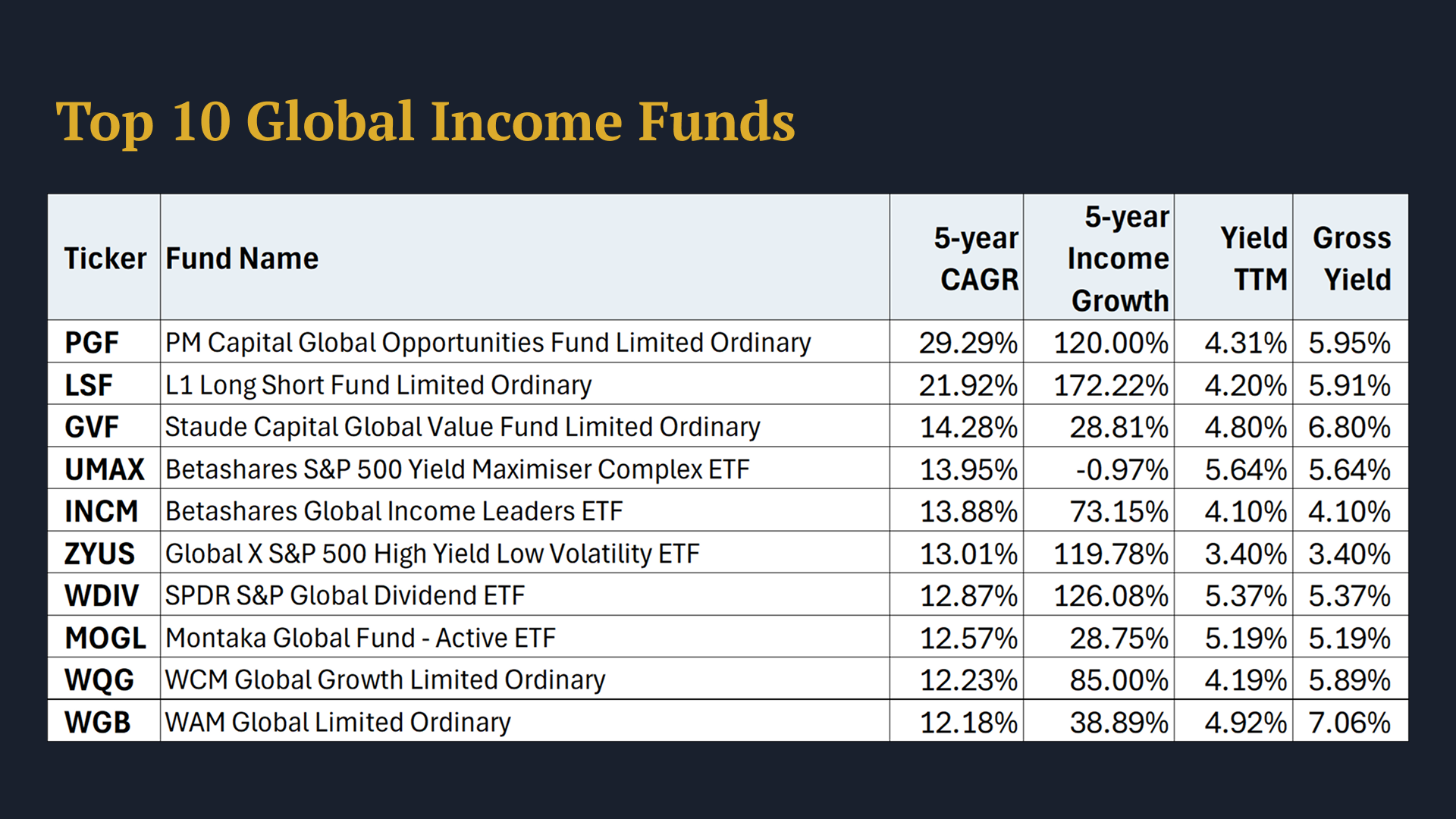The most consistent ASX dividend ETFs & LICs
"If you don’t find a way to make money while you sleep, you will work until you die." - The legendary Warren Buffett
Buffett’s famous words are a reminder of why building passive income streams matters. Getting paid by your portfolio doesn’t just supplement your lifestyle, it can be the key to financial freedom and escaping the 9-to-5 grind.
One of the simplest ways to do this is by collecting steady cheques from diversified funds that deliver reliable income.
But when it comes to building quality income streams – as many Livewire readers know – the goal isn’t to chase the fattest yields and fall into dividend traps. Quality matters as much as quantity.
That’s exactly what this study set out to uncover. After analysing hundreds of listed investment products, we’ve identified the 10 most consistent Australian and global equity income funds over the past five years — funds that have:
✅ Paid uninterrupted dividends
✅ Avoided material distribution cuts
✅ Combined high, reliable income with long-term growth
Catch the YouTube summary or dive into the full write-up below.
the methodology
This wire was created for investors looking to build reliable income streams to support their retirement or a FIRE lifestyle. The goal was to strike a balance between good performance and consistency. Here’s the process we used:
1. Listed, diversified funds only
This wire is designed for investors seeking investment vehicles with built-in diversification who don’t want the hassle of picking individual stocks. As such, we focused only on listed diversified vehicles including exchange-traded funds (ETFs) and listed investment companies (LICs) due to the accessibility of data.
If you’re after the most consistent individual shares, my colleague Carl Capolingua has covered the most consistent ASX dividend stocks - which I highly recommend reading!
2. Five-year total returns
Only funds with at least five years of history were included. We ranked them by their 5-year CAGR (compound annual growth rate), as this period is long enough to test performance and income consistency across different market conditions. The rationale is simple: income shouldn’t come at the expense of capital.
3. Uninterrupted dividends – and no material cuts
From this list of top performers, we excluded any fund that missed a payment or materially reduced its annual distribution at any time in the past five years. Dividends had to be at least consistent, if not higher, in FY25 compared to FY21.
The 5-year income growth figures in the tables below reflect the total increase in payments, based on dividends declared from FY21 to FY25.
4. Realistic income thresholds
We then filtered the list for funds with a trailing twelve month (TTM) yield of at least 4% for Australian equities and 3% for global equities before franking, focusing on strategies that deliver a meaningful income straight out of the gate.
The lower threshold for global funds reflects the reality that international markets typically offer lower dividend yields than the ASX – and even the Australian market has faced significant yield compression in recent years.
5. Sustainable sources of income
Many global equity and growth funds reported inflated yields in FY25 (often above 8%) despite benchmarks like the MSCI World yielding just 1.72%. These one-off spikes were typically the result of capital gains from portfolio rebalancing, not genuine dividend income. We excluded these funds to focus on consistent, recurring income streams.
To be conservative, where an issuer reported a lower yield than the Market Index calculation (which simply divides total distributions by share price), we used the issuer’s lower figure to better reflect the natural level of income from the portfolio.
6. A note on LICs/growth strategies
Some of the names in the tables below such as PM Global and L1 Capital weren’t originally designed as income strategies. Nonetheless, they’ve delivered consistent dividend growth, attractive yields, and, in some cases, adopted distribution policies that appeal to income investors - making them unexpected income champions.
The most consistent Australian equity income funds
Based on the process outlined above, we’re delighted to present the 10 most consistent listed Australian equity income strategies, and I note the three key themes from this list below.

#1 - Banks are back with a vengeance
Australia’s income landscape is still built on financials, so it’s no surprise that bank-heavy ETFs led the way. Strong share price gains and dividend growth from the major lenders over the past five years powered much of the outperformance.
The VanEck Australian Banks ETF (ASX: MVB) topped the list with a 20.66% p.a. return and a 140% jump in dividends over the period. The blazing post-COVID performance of Australia’s big banks also supported other ETFs with significant financials exposure including:
- SPDR S&P/ASX 200 Financials ex A-REIT ETF (ASX: OZF)
- SPDR MSCI Australia Select High Dividend Yield ETF (ASX: SYI)
- BetaShares FTSE RAFI Australia 200 ETF (ASX: QOZ)
- Russell Investments High Dividend Australian Shares ETF (ASX: RDV)
- Russell Investments Australian Responsible Investment ETF (ASX: RARI)
- Vanguard Australian Shares High Yield ETF (ASX: VHY)
The scale of their performance and income increases varied depending on each fund’s strategy — particularly their weighting to banks. For example, VanEck’s methodology caps individual stock weights at 20% and holds only banks, benefiting at different times as Westpac, CBA, NAB, and Macquarie each enjoyed periods of strong outperformance.
It’s important to note that while the capital and dividend growth figures for many of these funds look staggering, the five-year period began in the depths of COVID, when ASX 200 dividends were heavily cut and equities were reeling from the pandemic.
Much of the growth since then reflects a normalisation of payouts rather than extraordinary dividend expansion by companies.
Nonetheless, banks are likely to remain a key source of income in portfolios, supported by the oligopolistic structure of Australia’s lending market, solid economic growth, strong housing and credit demand, and a steady influx of new customers driven by immigration.
#2 - LICs deliver high yields and franking benefits
LICs such as Spheria Emerging Companies (ASX: SEC) and Sandon Capital Investments (ASX: SNC) maintained fully franked dividends and gross yields north of 6%, making them attractive for retirees seeking franking credit refunds.
Spheria looks to navigate opportunities in the small- and mid-cap part of the market, and Portfolio Manager Brittany Isakka has been shooting the lights out with some of her summer picks, including TechnologyOne (ASX: TNE), Turners Automotive (ASX: TRA), and Supply Networks Limited (ASX: SNL), which remain top holdings for SEC and supported the strategy's CAGR of nearly 18% p.a.
.jpg)
SEC has also become more shareholder-friendly on the income front, adopting a policy in 2021 of paying out 1% of its post-tax net tangible assets (NTA) on a quarterly basis.
Sandon Capital, meanwhile, takes an "activist approach" to unlocking value from companies, generally in the Australian small- and mid-cap space. Its SNC LIC can also hold unlisted and internationally listed investments. Its top holdings include Fleetwood (ASX: FWD) and COG Financial Services (ASX: COG). SNC also moved to quarterly income payments this year.
#3 - Australian property securities quietly deliver
Since COVID-19 pushed people out of offices and tech stole the spotlight in global equities, Australian real estate investment trusts (A-REITs) have lost some of their shine.
While past performance isn't indicative of future returns, the impressive run of the Vanguard Australian Property Securities Index ETF (ASX: VAP) shows that it might be time to rekindle the love affair investors once had with A-REITs.
While franking is minimal, REITs are delivering 4%+ yields alongside solid growth potential – a compelling mix in a world where income diversification matters. With workers once again crowding public transport to reach the many office buildings these trusts own – and with sub-themes like fulfilment warehouses, data centres, storage units, and shopping malls gaining momentum – the case for A-REITs is strengthening.
The most consistent global equity income funds
We now apply the same process to global ETFs and LICs - except for a lower minimum cash dividend requirement of at least 3% - and break down the key themes from the list below.

#1 - LICs lead the way in global income
LICs were the clear global standouts, with five strategies from PM Capital, L1 Capital, Wilson Asset Management, WCM, and Staude Capital making the list.
Topping the rankings were the PM Capital Global Opportunities Fund (ASX: PGF) and the L1 Long Short Fund Ltd (ASX: LSF), delivering nearly 30% p.a. and 21.92% p.a., respectively, alongside some of the highest dividend growth rates in the cohort.
Led by Paul Moore, PGF invests in a concentrated portfolio of undervalued global equities with a distinctly different mix to most strategies. Its largest sector exposures are European banks (31%) and industrial metals (15%), with negligible tech exposure – a deliberate decision driven by valuations.
And it’s worked.
"We have continued to favour the ‘unloved’ European banks based on attractive valuations and improving shareholder returns, while warning against record-high valuations in the US and the investor euphoria surrounding a potential Trump presidency, which has fuelled a ‘risk-on’ mindset," Moore wrote in PGF's March 2025 quarterly report.
PM Capital also successfully shorted the NASDAQ this year and announced a FY25 dividend of 11 cents per share, supported by retained earnings of over $300 million – enough to sustain dividends at current levels for 6.3 years.
Meanwhile, LSF, led by Mark Landau and Raphael Lamm has been doing some clever manoeuvring of its own in global markets – keeping its Australian exposure “extremely low” relative to historic averages, increasing its short positions, and capitalising on M&A activity, with several underlying holdings boosted by takeover proposals.
L1 is also leaning into the European trade, where it sees compelling opportunities across several sectors, including banks, infrastructure, mining services, and construction materials.
"We believe our infrastructure and gold exposures provide a strong level of resilience for the portfolio in the event of additional volatility from trade and tariff measures or a further slowdown in economic growth, LSF said in its June 2025 quarterly report.
#2 – Covered call ETFs get the job done
Many of the ideas in this wire offer modest-to-decent starting yields, but if you care more about regular cash in your pocket now rather than waiting for dividend growth to play out, covered call strategies deserve a closer look.
The Betashares S&P 500 Yield Maximiser (ASX: UMAX) has been pumping out yields of around 6% by writing options over the S&P 500. Total returns have still been solid at above 13% p.a., making it a viable way to tap into low-yielding international markets with a high-income strategy - provided you’re comfortable trading off some potential capital growth compared to holding the S&P 500 outright.
Yes, its FY25 payout was slightly lower than in FY21, but that’s the nature of options-based income. The aim here is high, steady cash flow, not chasing year-on-year dividend growth.
#3 – Dividend ETFs can still deliver consistency
Yields offshore will probably never match Australia’s, but dividend-focused ETFs can still hold their own if you pick the right ones. Global X S&P 500 High Yield Low Volatility (ASX: ZYUS), SPDR S&P Global Dividend (ASX: WDIV), and Betashares Global Income Leaders (ASX: INCM) all show that international markets can provide decent income, diversification and surprisingly strong dividend growth rates. Meanwhile, LICs like WAM Global (ASX: WGB) can deliver an income kick given its relatively high cash yield, franking credits
conclusions
When looking back at this exercise, a few things really stand out.
The first is that investors shouldn’t blindly assume ETFs are the only game in town just because of the well-worn argument that active managers underperform over time. The lists above highlight the ability for active strategies to perform consistently and deliver solid income as well as growth.
The second is that it is possible to strike a balance between growth and income. Income should never come at the expense of capital — which is why we excluded several funds boasting eye-catching gross yields of 10%+. Too often, those payouts were coming from portfolios bleeding capital, and something will eventually give.
The third is the importance of dividend growth over time. Just as we all hope to receive pay rises or grow our businesses over the years, good stewards of capital should be increasing payouts for their investors over time.
Finally, past performance is no guarantee of future returns, but for investors seeking steady cash flow with a proven track record, these strategies are well worth a closer look.
5 topics
17 stocks mentioned
14 funds mentioned
4 contributors mentioned


